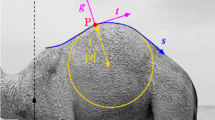Abstract
Gradient orientations are a common feature used in many computer vision algorithms. It is a good feature when the gradient magnitudes are high, but can be very noisy when the magnitudes are low. This means that some gradient orientations are matched with more confidence than others. By estimating this uncertainty, more weight can be put on the confident matches than those with higher uncertainty. To enable this, we derive the probability distribution of gradient orientations based on a signal to noise ratio defined as the gradient magnitude divided by the standard deviation of the Gaussian noise. The noise level is reasonably invariant over time, while the magnitude, has to be measured for every frame. Using this probability distribution we formulate the matching of gradient orientations as a Bayesian classification problem.
A common application where this is useful is feature point matching. Another application is background/foreground segmentation. This paper will use the latter application as an example, but is focused on the general formulation. It is shown how the theory can be used to implement a very fast background/foreground segmentation algorithm that is capable of handling complex lighting variations.
Access this chapter
Tax calculation will be finalised at checkout
Purchases are for personal use only
Similar content being viewed by others
References
Ardö, H., Åström, K.: Bayesian formulation of image patch matching using cross-correlation. J. Math. Imaging Vis. 43(1), 72–87 (2012)
Ardö, H., Berthilsson, R., Åström, K.: Real time viterbi optimization of hidden markov models for multi target tracking. In: IEEE Workshop on Motion and Video Computing (2007)
Baha, N., Larabi, S.: Accurate real-time neural disparity map estimation with fpga. Pattern Recogn. 45(3), 1195–1204 (2012)
Boykov, Y., Kolmogorov, V.: An experimental comparison of min-cut/max-flow algorithms for energy minimization in vision. IEEE Trans. Pattern Anal. Mach. Intell. 26(9), 1124–1137 (2004)
Dalal, N., Triggs, B.: Histograms of oriented gradients for human detection. In: IEEE Computer Society Conference on Computer Vision and Pattern Recognition, CVPR 2005, vol. 1, pp. 886–893, June 2005
Evangelio, R., Sikora, T.: Complementary background models for the detection of static and moving objects in crowded environments. In: 2011 8th IEEE International Conference on Advanced Video and Signal-Based Surveillance (AVSS), pp. 71–76 (2011)
Friedman, N., Russell, S.: Image segmentation in video sequences: a probabilistic approach. In: Thirteenth Conference on Uncertainty in Artificial Intelligence, pp. 175–181 (1997)
Gordon, G., Darrell, T., Harville, M., Woodfill, J.: Background estimation and removal based on range and color. In: IEEE Computer Society Conference on Computer Vision and Pattern Recognition, vol. 2, p. 464 (1999)
Goyette, N., Jodoin, P., Porikli, F., Konrad, J., Ishwar, P.: Changedetection.net: A new change detection benchmark dataset. In: 2012 IEEE Computer Society Conference on Computer Vision and Pattern Recognition Workshops (CVPRW), pp. 1–8 (2012)
Hu, W., Gong, H., Zhu, S.-C., Wang, Y.: An integrated background model for video surveillance based on primal sketch and 3d scene geometry. In: IEEE Conference on Computer Vision and Pattern Recognition, CVPR 2008, pp. 1–8, June 2008
Kohli, P., Torr, P.H.S.: Dynamic graph cuts for efficient inference in markov random fields. IEEE Trans. Pattern Anal. Mach. Intell. 29(12), 2079–2088 (2007)
Kondo, T.: Motion estimation using gradient orientation structure tensors. In: Proceedings of the Second International Conference on Innovative Computing, Informatio and Control, ICICIC 2007, p. 450. IEEE Computer Society, Washington (2007)
Lowe, D.G.: Distinctive image features from scale-invariant keypoints. Int. J. Comput. Vision 60(2), 91–110 (2004)
Möller, E., Grieszbach, G., Schack, B., Witte, H., Maurizio, P.: Statistical properties and control algorithms of recursive quantile estimators. Biometrical J. 42(6), 729–746 (2000)
Noriega, P., Bernier, O.: Real time illumination invariant background subtraction using local kernel histograms. In: Proceedings of the British Machine Vision Conference, BMVA Press, pp. 100.1–100.10 (2006). doi:10.5244/C.20.100
Toyama, K., Krumm, J., Brumitt, B., Meyers, B.: Wallflower: principles and practice of background maintenance. In: The Proceedings of the Seventh IEEE International Conference on Computer Vision, vol.1, pp. 255–261 (1999)
Wang, H., Suter, D.: Background subtraction based on a robust consensus method. In: 18th International Conference on Pattern Recognition, ICPR 2006, vol. 1, pp. 223–226 (2006)
Wayne, P., Johann, P., Schoonees, A.: Understanding background mixture models for foreground segmentation. In: Proceedings Image and Vision Computing (2002)
Author information
Authors and Affiliations
Corresponding author
Editor information
Editors and Affiliations
Rights and permissions
Copyright information
© 2015 Springer International Publishing Switzerland
About this paper
Cite this paper
Ardö, H., Svärm, L. (2015). Bayesian Formulation of Gradient Orientation Matching. In: Nalpantidis, L., Krüger, V., Eklundh, JO., Gasteratos, A. (eds) Computer Vision Systems. ICVS 2015. Lecture Notes in Computer Science(), vol 9163. Springer, Cham. https://doi.org/10.1007/978-3-319-20904-3_9
Download citation
DOI: https://doi.org/10.1007/978-3-319-20904-3_9
Published:
Publisher Name: Springer, Cham
Print ISBN: 978-3-319-20903-6
Online ISBN: 978-3-319-20904-3
eBook Packages: Computer ScienceComputer Science (R0)




